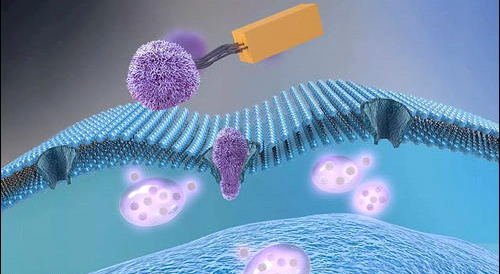文献:MICRORHEOLOGICAL QUANTIFICATION OF CELL-MEDIATED REMODELING OF POLYMER-PEPTIDE HYDROGELS IN RESPONSE TO CHEMICAL CUES
摘要:
The next chapter describes the development of a new technique to create hydrogels with tethered concentration gradients of polymers or proteins. This technique also enables us to measure the diffusion coefficient of solutes in hydrogels. Hydrogels with tethered concentration gradients of cell signaling molecules can be used to direct cell migration from the scaffold to the wound after implantation. A rectangular prism is the basis of our microfluidic device. Before using the microfluidic device to create hydrogels with a tethered concentration gradient of TNF-α, we make concentration gradients with a model polymer, Fluorescein poly(ethylene glycol)-thiol (FITC-PEG-SH), to validate the technique. We first make a calibration curve by measuring hydrogels with known concentrations of FITC-PEG-SH and measure their arbitrary brightness using a laser scanner. This calibration curve relates brightness with tethered molecule concentration. We form hydrogels with tethered concentration gradients of FITC-PEG-SH by allowing the molecule to diffuse for 6, 24 and 48 hours. Hydrogels with tethered concentration gradients of FITC-PEG-SH are placed on the laser scanner and spatial brightness is measured. The calibration curve is then used to back-calculate local concentrations every 25 micrometers along the hydrogel. Next, we curve-fit a solution of Fick’s second law of diffusion to calculate the effective diffusion coefficient of FITC-PEG-SH. In the FITC-PEG-SH experiments, we hypothesize that steady state diffusion is reached when a gradient forms for 24 hours. We use the same method to make concentration gradients of thiolated and dyed TNF-α tethered into hydrogels.

该技术可以制造具有聚合物或蛋白质束缚浓度梯度的水凝胶。该技术还使我们能够测量水凝胶中溶质的扩散系数。具有细胞信号分子系留浓度梯度的水凝胶可用于在植入后引导细胞从支架迁移到伤口。矩形棱镜是我们微流体装置的基础。在使用微流体装置制造具有TNF-α束缚浓度梯度的水凝胶之前,我们用模型聚合物荧光素聚乙二醇硫醇(FITC-PEG-SH)制作浓度梯度,以验证该技术。
我们首先通过测量已知浓度的FITC-PEG-SH水凝胶来绘制校准曲线,并使用激光扫描仪测量其任意亮度。该校准曲线将亮度与系留分子浓度联系起来。我们通过让分子扩散6、24和48小时,形成具有FITC-PEG-SH束缚浓度梯度的水凝胶。将具有FITC-PEG-SH束缚浓度梯度的水凝胶放置在激光扫描仪上,并测量空间亮度。然后使用校准曲线沿水凝胶每25微米反向计算一次局部浓度。接下来,我们对菲克第二扩散定律的解进行曲线拟合,以计算FITC-PEG-SH的有效扩散系数。在FITC-PEG-SS实验中,我们假设当梯度形成24小时时达到稳态扩散。我们使用相同的方法使巯基化和染色的TNF-α的浓度梯度固定在水凝胶中。
测量比预测理论值快一个数量级的有效扩散系数。在创建多个水凝胶复制品后,我们假设更快速的扩散是由于TNF-α和水凝胶交联剂之间的静电吸引。这种方法可以放大或缩小,以制备具有系留浓度梯度的水凝胶,用于细胞递送,或测量水凝胶中聚合物或蛋白质的扩散系数。
相关推荐:
AA-PEG-AA
Alkyne-PEG-SVA
PLGA(2K)-PEG-SC
DBCO-PEG-SVA
Gala-PEG-SCM
Gluc-PEG-SCM
SCM-S-PEG-S-SCM
SVA-PEG-SVA
SPA-PEG-SPA
SAS-PEG-SAS
GAS-PEG-GAS
SG-PEG-SG
以上文章内容来源各类期刊或文献,如有侵权请联系我们删除!




 齐岳微信公众号
齐岳微信公众号 官方微信
官方微信 库存查询
库存查询